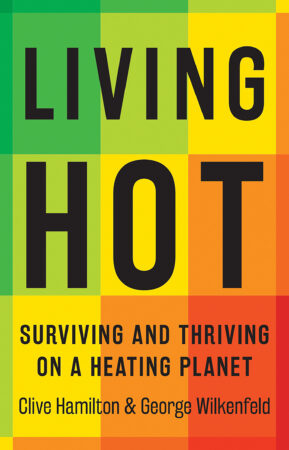By John Weldon
Hamilton and Wilkenfeld pull no punches in this (very readable) discussion of the current and future state of climate change in Australia and, more importantly, our attitude to it and the actions we need to take NOW in the face of it.
They argue that Australia is currently focusing on the wrong climate goals. We are such a small player on the global stage that whether we reduce emissions or not, will make no difference to halting or reversing climate change.
Not that we should stop finding ways to reduce our carbon footprint; we should because that’s the moral thing to do and because, at the very least, we’ll be setting an example. But we should stop pretending that we have the power to make a difference.
What the authors maintain we should focus on, is an honest assessment of our climate change situation. This should then lead to pragmatic and practical measures that protect our infrastructure, way of life and our environment, by learning to adapt to the reality of life lived under a changed and still changing climate.
We can no longer afford to defer concrete action in favour of amorphous and difficult to grasp promises of ‘Net zero by 2050’ and other measures which serve only to distract us from what is happening today.
Such nebulous targets, Hamilton and Wilkenfeld argue, enable us to ignore the reality of our situation. They make it easier for us to believe that the once-in-a-hundred-year-floods and fires that now seem to happen with alarming regularity won’t continue to increase in frequency, that the boffins will find a solution, thereby allowing us to continue on our merry way pretending that the future will be better.
This approach to climate change leaves us “disinclined to believe and respond to threats that remain abstract and uncertain or require disruption to life patterns.” We need to make climate threats, and our responses to them, concrete if we are to convince people to embrace what may, for some, turn out to be unpleasant and inconvenient, yet necessary new understandings of how and where we live in this country.
To achieve this, they argue we need a ‘transformative adaptation’ approach to devastating climate events rather than an emotional, sentimental one. Instead of building back ‘like for like’ after floods and fires destroy towns and cities, we should consider building back better or, in many cases, somewhere else. We need a government-led and funded ‘planned retreat’ from flood plains, coastal regions at risk, and areas of the country prone to fire or heat-related events.
But, and there’s always a but, the biggest issue we face, in relation to that kind of adaptation, is that no government, with an eye on another term, would dare yell “retreat”. Far better to set emission reduction targets so far into the future that they are practically meaningless today, than to be the government that admits the climate is broken NOW.
In that sense, this is a confronting book, but it’s also reassuring, as it suggests there are measures we can take to ensure Australia remains liveable.
To begin with, Living Hot calls for an urgent and sustained national conversation about climate change involving all levels of government. Easier said than done when, as the authors readily admit, “The feds have the money, the states the power and the local governments have the responsibility,” meaning there is little coordination between the three levels of government in regard to this issue. If we cannot persuade government at all levels to cooperate then we the people need to replace those in power. But replace them with who? We live in a country where politics is dominated by two parties, neither of which seems willing to come to grips with the issue on their watch. In this respect our ability to influence government action on climate change begins to appear as non-existent as this country’s capacity to reverse global climate trends.

But all is not lost. If we the people want change then we have to take action, we need to mobilise, to lobby, or to run for, local councils, to get in the ears of MPs, to push for realistic action instead of ‘starry-eyed’ enthusiasm for unrealised future-focused, solve-all projects and plans.
Big call. If you’re ready to answer that, then this is the book for you.
Authors: Clive Hamilton & George Wilkenfeld
Publisher: Hardie Grant

